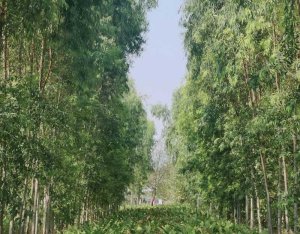“Every year, we are planting 15 to 20 thousand hectares of plantation on farmers’ land which is way more than our requirements”, says Mr. Sanjay Singh, Group Head – Paper & Packaging at ITC Ltd.

The afforestation programme of ITC Ltd. brings multiple benefits to multiple stakeholders. Plantation incomes are significantly higher, especially beneficial for poor farmers, helping them to step away from penury and deprivation. For Indian paper producers, the plantations create a raw material source that is local, renewable, and responsible. They also contribute to expanding the country’s green cover thereby enabling large-scale sequestration of carbon dioxide, enriching depleted soils, and replenishing groundwater. In an interview with Paper Mart, Mr. Sanjay Singh, Group Head – Paper & Packaging at ITC Ltd. talks in detail about the company’s social and farm forestry programmes.
Paper Mart: Please tell us about your pro-afforestation schemes. How much area is covered under plantations by you and what percentage of raw materials do you procure from social and farm forestry?
Sanjay Singh: ITC’s Afforestation Programme assists farmers to turn their unproductive land assets into profitable pulpwood plantations, using clonal saplings specially developed by ITC R&D to grow in harsh conditions. We get a hundred percent of our raw material from plantations done either by us or by the forest department. Not a tonne is taken from natural forests. Every year, we are planting 15 to 20 thousand hectares of plantation on farmers’ land which is way more than our requirements.

The company’s pioneering afforestation initiative is currently spread across 17 districts in 8 states covering over 3.94 lakh acres in 5,694 villages, and impacting over 1.28 lakh households. Together with the company’s farm forestry programme, this initiative has greened over 8.76 lakh acres to date and generated about 160-million person-days of employment for rural households, including poor tribal and marginal farmers. Integral to the social forestry programme is the agroforestry initiative, which cumulatively extends to over 1.23 lakh acres.
PM: Tell us about the hardwood and softwood trees that are grown by the mill. Do you think that sourcing wood from farm forestry is a win-win situation for both mills as well as farmers who want a steady source of income?
SS: We are growing only hardwood trees like Eucalyptus, Casuarina, and Subabul. Our plantation programme is a win-win situation for us as well as farmers. For small farmers who need a regular income, we follow the social forestry model wherein the trees are widespread, and in-between they can grow crops like maize and chickpea. From these yearly crops, they are able to make ends meet and after four years they get a lump sum from harvesting trees. We also encourage farmers with sufficient finances, who are not dependent on yearly crops, to grow pulpwood plantations on low productivity/degraded landholdings for higher earnings and environmental benefits. Thus, we cater to all types of farmers.
PM: Do you think that India’s agroforestry policy is a step in the right direction? How do you think the recent announcement of policies and legislative changes to promote agroforestry and private forestry in Budget 2022 will help?
SS: The recent announcement by the Government of India in this financial year’s budget should go a long way in promoting forestry and growing trees for various sectors in the country. For the pulp and paper industry, it is a step in the right direction. We would like to work closely with the government on these projects. It helps to improve employment in rural areas which will reduce migration from villages to towns.
Watch: Evolution of Paper Based Packaging
“The recent announcement by the Government of India in this financial year’s budget should go a long way in promoting forestry and growing trees for various sectors in the country.”
PM: Have you been able to improve the productivity of degraded lands, control soil erosion, and push moisture conservation through your social farm forestry program?
SS: The paper mills that make their own pulp have survived only because of the agroforestry model. In this arrangement, we work with small and marginal farmers and on wastelands that were lying idle. This has helped in substantially increasing the green cover, improving the quality of soil, controlling soil erosion, increasing water level, and improving farmers’ income.

“We also encourage farmers with sufficient finances, who are not dependent on yearly crops, to grow pulpwood plantations on low productivity/degraded landholdings for higher earnings and environmental benefits.”
Also Read: Paper Boat Needs WATER to Float… Save it!
PM: What are ITCs future targets in the area of farm forestry?
SS: ITC’s Afforestation Programme aims at greening degraded lands, creating sustainable livelihoods, and augmenting India’s green capital through multi-stakeholder partnerships. Moreover, growing more trees will even lay the groundwork for setting up new pulp mills, which, in turn, will enable the country to save foreign exchange.



